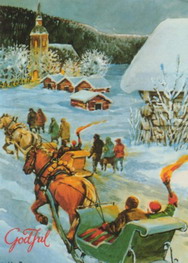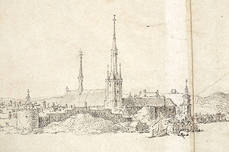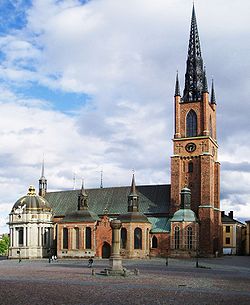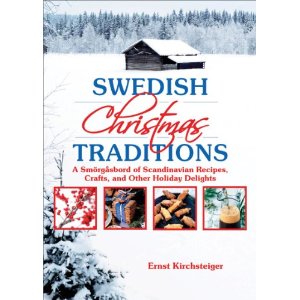|
Julotta in SwedenJulotta i Riddarholmskyrkan or
|
(Early Christmas Morning Service)
when: Dec 2010 (annual)
where: Skansen
time: 7am
Julotta in Sweden
The Early Christmas Morning Service - or Julotta - in Skansen's Seglora Kyrka church is a very atmospheric way to start the festivities of the day...with the path up to the church lined with torches.
In olden times, Christmas Day was the most important day for going to church during the holiday season. The ride to church was a festive one, and people used their most beautiful sleds and finest harnesses. Both those who walked and those who rode in sleds used torches to light the way. The bells on the harnesses also helped to make the ride extra special.
The ride to church was dignified and stately, whereas the ride home often resembled a race, as it was generally believed that the person who got home first after the service would also be the first to have his harvest gathered the following summer.
Event details can change. Please check with the organisers that the event is happening before making travel arrangements.
Original information here
Memory of 2007:
A 2007 invitation to Julotta in Sweden (in Swedish):
"Julotta i Riddarholmskyrkan 2007-12-25 - 2007-12-25
Julotta 25 december 07:00 Riddarholmskyrkan. Enda chansen på hela året att vara med om en gudstjänst i Riddarholmskyrkan!
[Translated: “Julotta” 25. December at 7:00AM, Riddarholms Church. The only chance all year to participate in a service in the Riddarholm Church.]
The morning is dark and starlit, the snow glistens in the cold air. It is Christmas morning. The snow on the ground outside the Riddarholm church is trampled by many feet this special morning. From inside the church is heard christmas songs and reflective words. When the door opens a large crowd is celebrating “julotta”. The church is lit by candles – in swedish called “levande ljus”. The mood is warm in spite of the winter cold.
Since the church is not heated, we recommend that you dress warmly and bring a blanket to keep warm while seated."
Julotta in Sweden
Attending julotta in Sweden is to many Swedish Americans one of the most treasured of memories. Snow is connected with it and sleigh bells and a journey across the countryside in the dark morning hour, brightened by the flickering flames of torches.
Many have memories of a city church within walking distance, and they remember with no less feeling of nostalgia how the snow crunched under the feet and how the light streamed out of the windows as they approached the church.
 Julotta in Sweden
Julotta in Sweden
Thus, each one of us gathers memories out of the milieu from which we come. But to all of us the message of Christmas and the singing of "Var hälsad, sköna morgonstund" (literally, be greeted beautiful morning hour) constitute common ground. This hymn is still numbered 55 in the revised hymnal of the Swedish State Church, and the manner in which it is sung each Christmas morning indicates clearly that the congregation knows it by heart.
A Minnesota professor of Swedish descent, now deceased, maintained that it was a mistake to sing this hymn in an English translation. It had only one version, according to him, and that was the Swedish. "That is the way I learned it as a child and that is the way I continue to sing it regardless of what the rest of the congregation sings," he would say with an emphatic nod.
Each one who has attended early Christmas Day service in a Swedish church could write his own version and each one would be different from the other. A University of Minnesota student who studied in Stockholm a few years ago was a guest of relatives in Skåne at Christmas and attended julotta in a small church there.
He gave his impressions of the holidays in a letter this way: "My relatives were among the most generous, most warmhearted, kindest people I have ever known. They seemed so happy to have me and I enjoyed myself so much that I stayed a whole week. There was plenty of food in Skåne!
One day I counted seven times at the table. Christmas Eve dinner was eaten by candle light. I insisted on going to julotta, and as they had no car I walked the three miles to the nearest church, the kind of church I had always dreamed of worshipping in for julotta in Sweden. It was set on a high hill in a small village and with the lights from candles, the village Christmas tree lights, and the candlelight from all the village houses, the scene was visible for miles around.
It was quite fantastic - a Danish type church, whitewashed, red tile roof, stepped front, and eight centuries old. The inside, lighted with candles, was decorated with evergreens and two large Christmas trees.
“Var hälsad, sköna morgonstund” could never have had a more beautiful earthly setting. The minister himself was quite marvelous well padded with good Skåne food, so that his heavy jowls made his bib pop up and down as he preached. His sermon on Saint John's chapter on “The Light” was meaningful and presented in a personal, ordinary tone not always characteristic of Swedish pastors.
As I walked home through the woods and hills, the sun came up and I realized that it had been a long time since I had felt such peace and satisfaction."
 History of julotta at RIDDARHOLMSKYRKAN
History of julotta at RIDDARHOLMSKYRKAN
WHEN CHRISTMAS MORNING GLEAMS…
Translated excerpts (from the Swedish)
Each year great crowds congregate again for julotta in Riddarholm church. Once a year the old medieval church lives again as something more than a picturesque tourist attraction.
The song rises among the arches and in the cold morning air we listen again to the story of the miracle of Bethlehem that set such lasting marks in our culture and in our lives.
We meet old and new friends, feel the warmth and the companionship and experience together the real meaning of Christmas and its message. It is the way it has happened for 60 plus years and so it is destined to continue for many years to come. Securely anchored traditions are things we should not so easily change.
The initiative to Christmas celebrations at Riddarholms church was taken by an organization called “Stockholms Scoutkår” as late as 1937. The question is how a crowd of weathered and enthusiastic scout leaders could have come up with such an idea.
Riddarholmskyrkan shows, as we know a rather indifferent attitude in winter, no heating, no seating, and no electricity. The cool climate has not seemed to be a problem for experienced outdoor people. They have become accustomed to adjust their clothing to the circumstances. Other problems have through the years been gallantly handled thanks to friendly donors and scouts from Kungsholmen-Väpnarna that early on showed what is the high point of Christmas, at least where they are concerned. More than 400 candles were donated by “BLIFA” (since 1971 the gift came from Liljeholmens candle factory) to light up the church. The same number of chairs was placed to make visitors more comfortable.
Thus it was Stockholms Scoutkår that started the celebration of julotta in Riddarholms church. When there was a division in 1943/44 the district took over the tradition. It was based on the core of the old arrangements. The program has basically remained the same with banner parades, choral singing, etc.
In connection with the 20-year jubilee the legendary Pontus Lonberg pointed out the need for reform or renewal, but any great changes did not take place.
The list of priests that made their appearance in the past 50 plus years contains a number of interesting names. During the starting year of 1937 the church leader Oscar Krook made his appearance. Later followed Arvid Lund, Olle Nystedt, and in 1950 Wilhelm Schröder. Some years later we find Stockholms future district chief John Evaldsson and in 1960/61 the future bishop Ingemar Strom visited the church. The year thereafter we find the debut of one of the most faithful officials: Assar Fjelkman, who led the julotta no less than fourteen times.
In the 1980s the first woman makes her entrance and adds another dimension to the traditional ceremony: Lisbeth Carlborg. She led the julotta 1981-1984.
Right from the start many excellent sounding choirs have favored the julotta. The beginning was the best imaginable with a scout chorus, led by the prominent and well-known conductor Rolke Rooth from the KFUM. He and his choir participated several times during the first few years. Under the major part of the 1950s an onwards choirs like Hedvig Eleonora’s scout chorus, and a girls chorus from Vallingby provided the singing. In 1980 the scout chorus under the baton of Bjorn Wester made its debut and then took over a definitive role in 1983.

 Among other traditional participants we must not neglect to mention the introductory banner parade that has been part of the ceremony from the start. It was resilient boys taking part during the first few years. Already in 1949 it was pointed out that there was a need for relief so that not the same boys had to remain standing the entire duration.
Among other traditional participants we must not neglect to mention the introductory banner parade that has been part of the ceremony from the start. It was resilient boys taking part during the first few years. Already in 1949 it was pointed out that there was a need for relief so that not the same boys had to remain standing the entire duration.
Seating has been arranged every year according to old newspaper stories. A certain reluctance was observed in the beginning. In 1946 tickets that promised only standing room were issued, and in 1950 it was shown that seating was only provided for approximately half of the church.
The interest from the mass media has scarcely been overwhelming. Though in 1954 one of the large Stockholm newspapers featured the event in grand style in a report under the headline “Julotta in Riddarholmskyrkan” amid banners and illustrated with a torch-bearing scout Lars Wåhlin.
A record attention happened in 1980, when the arrangement was broadcast on TV and an expectant general public amassed in such numbers that the regulars hardly could find room in the church.
Collections have naturally been taken every year, whereby old-fashioned scout hats have been substituted by a more timely utility. It was clear from the beginning that the arrangement had to be self-sustaining. After the first year it was noted that the arrangement had not entirely paid for itself, but it was expressed that hopefully it could be corrected the following year. One of the main investments was the purchase of candleholders.
In the beginning the collection was to support Stockholms Scoutkårs and later Stockholms Scoutdistrikts activities. From the middle of the 1950s the collections were dominated by a number of groups such as the handicapped, and also worldwide charitable organizations.
Snow or sleet, early or late Christmas Eve, most likely we’ll see each other again at Riddarholmskyrkan when the candles are lit on Christmas morning.
Read the original Swedish
here.
Julotta in Sweden
Home

